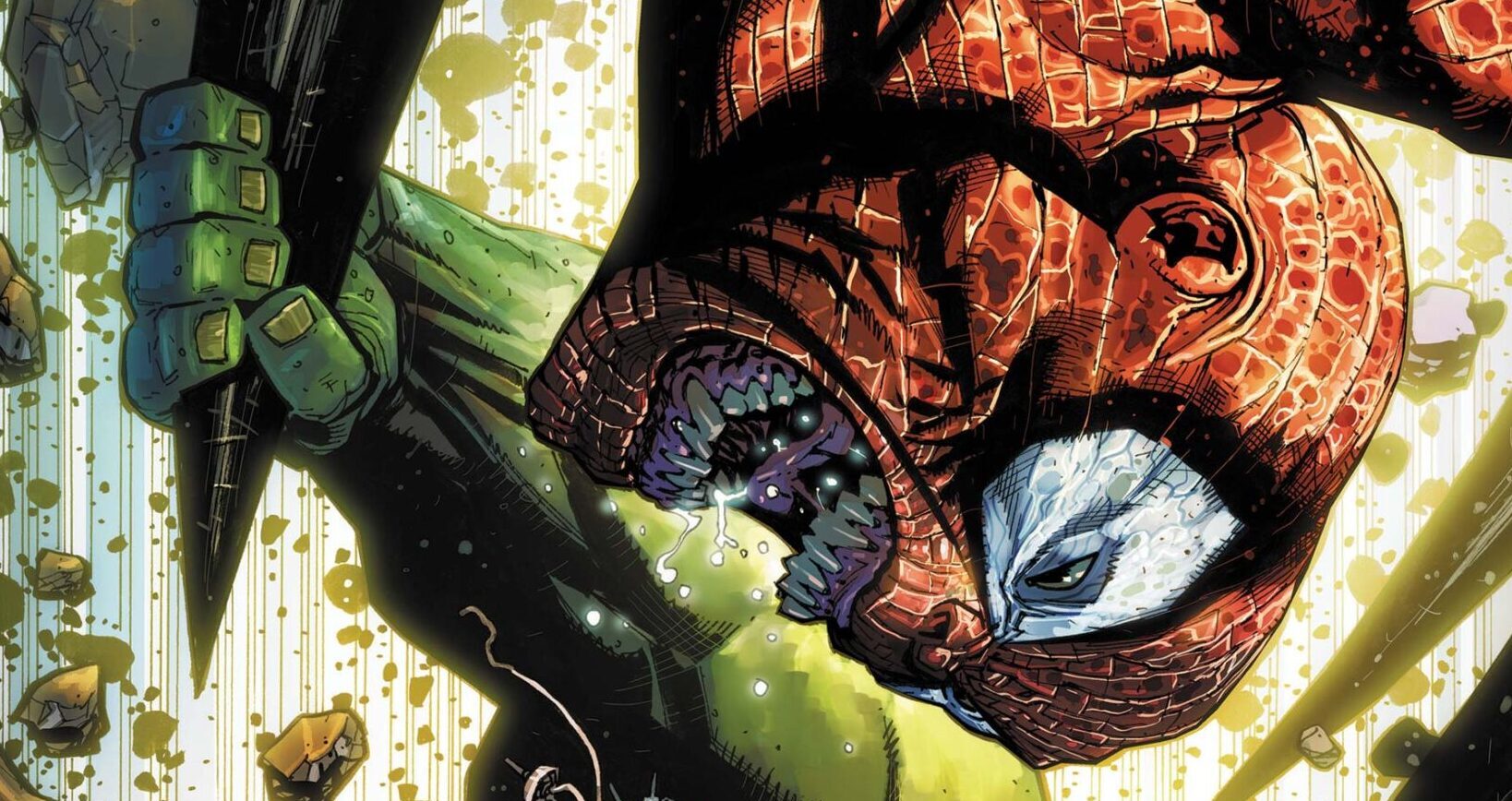Table of Contents Show
The first story arc of the current Hulk run builds to its impending conclusion in Hulk #5 (2022) by Donny Cates (writer), Ryan Ottley (penciller), Cliff Rathburn (inker), Frank Martin (colorist), VC’s Cory Petit (letterer), and Wilson Moss and Alanna Smith (editors).
Mutiny On Starship Hulk
The issue opens with the alternate Banner being interrogated by Ross, who demands to know what Starship Hulk is and how he is being controlled. The scientist responds that he’s “me when I’m angry” and he can’t be controlled.
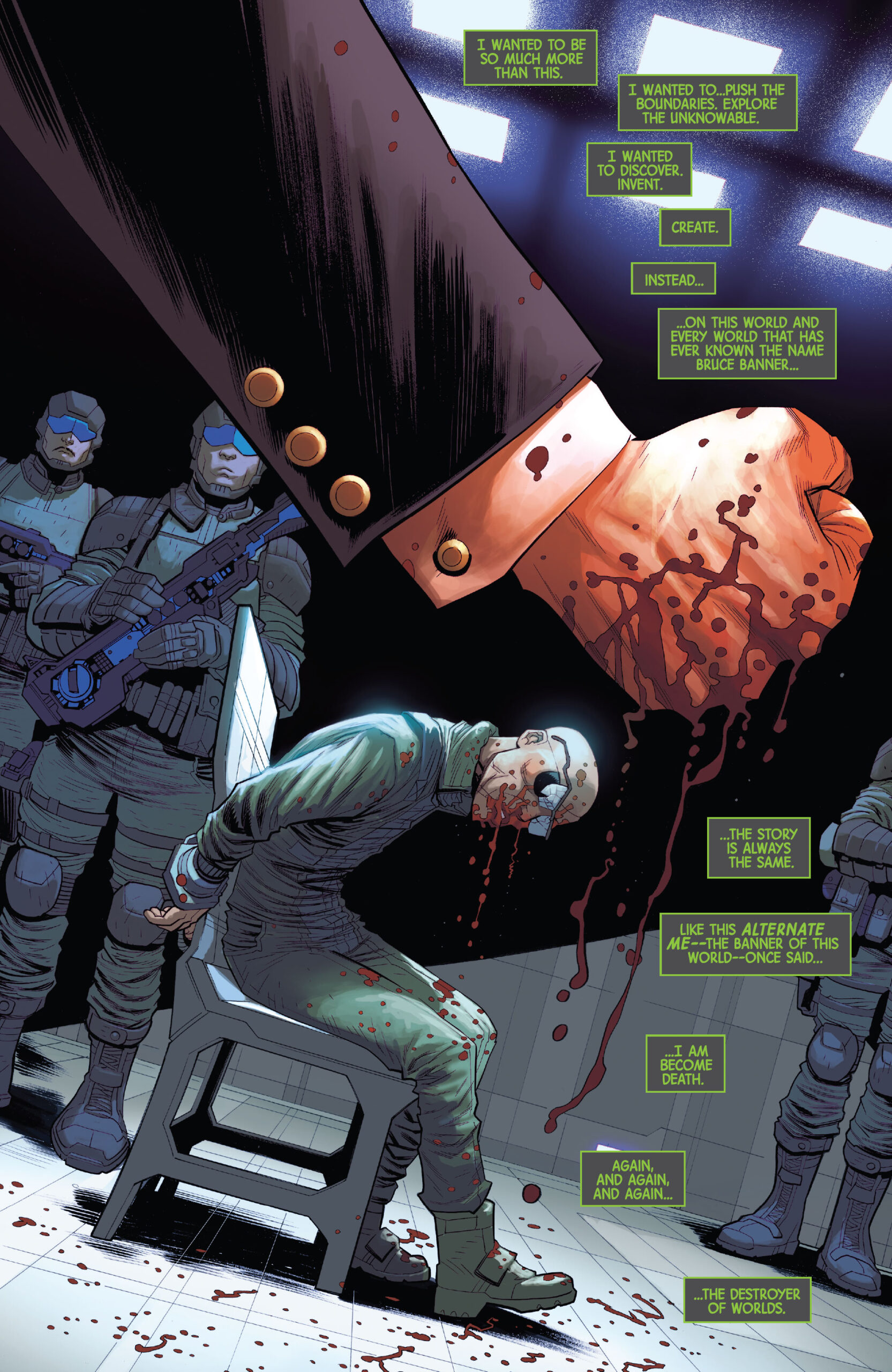
We then cut to the battle between Starship Hulk and Spider-Hulk that began last issue, with the green goliath being pinned to a wall by the mutated arachnid. Within Starship Hulk’s mind, “our” Banner is confronted by the false Betty Ross from previous issues, who urges him not to hurt Spider-Hulk — he’s “just a child,” and Banner should know better than anyone that “hurt people hurt people.”
Ignoring her, Banner pulls a lever on his control panel and increases the threat level of the illusory foes the original Hulk is facing, pitting him against the Asgardians in an effort to cause him to generate enough “rage energy” to defeat Spider-Hulk. As Starship Hulk’s power levels rise, Banner pushes a button labeled “smash,” prompting a knockout punch that fells Spider-Hulk.

Briefly cutting back to Ross and the variant Banner, we see the variant beg for mercy — he’s told Ross everything about how he tried to cure their world’s gamma-mutated Abominations. In response, Ross orders his men to leave the room, flashing an evil grin — he’s in no danger, Banner “wouldn’t hurt a fly.”
Chaos In The Mind-Space
The book then abruptly cuts back to the fight. As Spider-Hulk lies beaten on the ground, he de-mutates back into Peter Parker– who is promptly crushed by one of several strange black objects that are air-dropped onto the battlefield. The same event causes an explosion within Starship Hulk’s mind-space, knocking Banner back and blowing a hole in the wall of the room, revealing inky black darkness beyond. Betty Ross stands over Banner, telling him that he “worries too much.”
Cutting back to the variant Banner being interrogated, Ross reveals to him the secret of his empire — he’s been keeping the more powerful Abominations and sending them into battle. This is how his presidential administration has won so many wars. The variant Banner calls him “sick,” but Ross refutes his insult, calling himself a “patriot” for turning the United States into an empire.
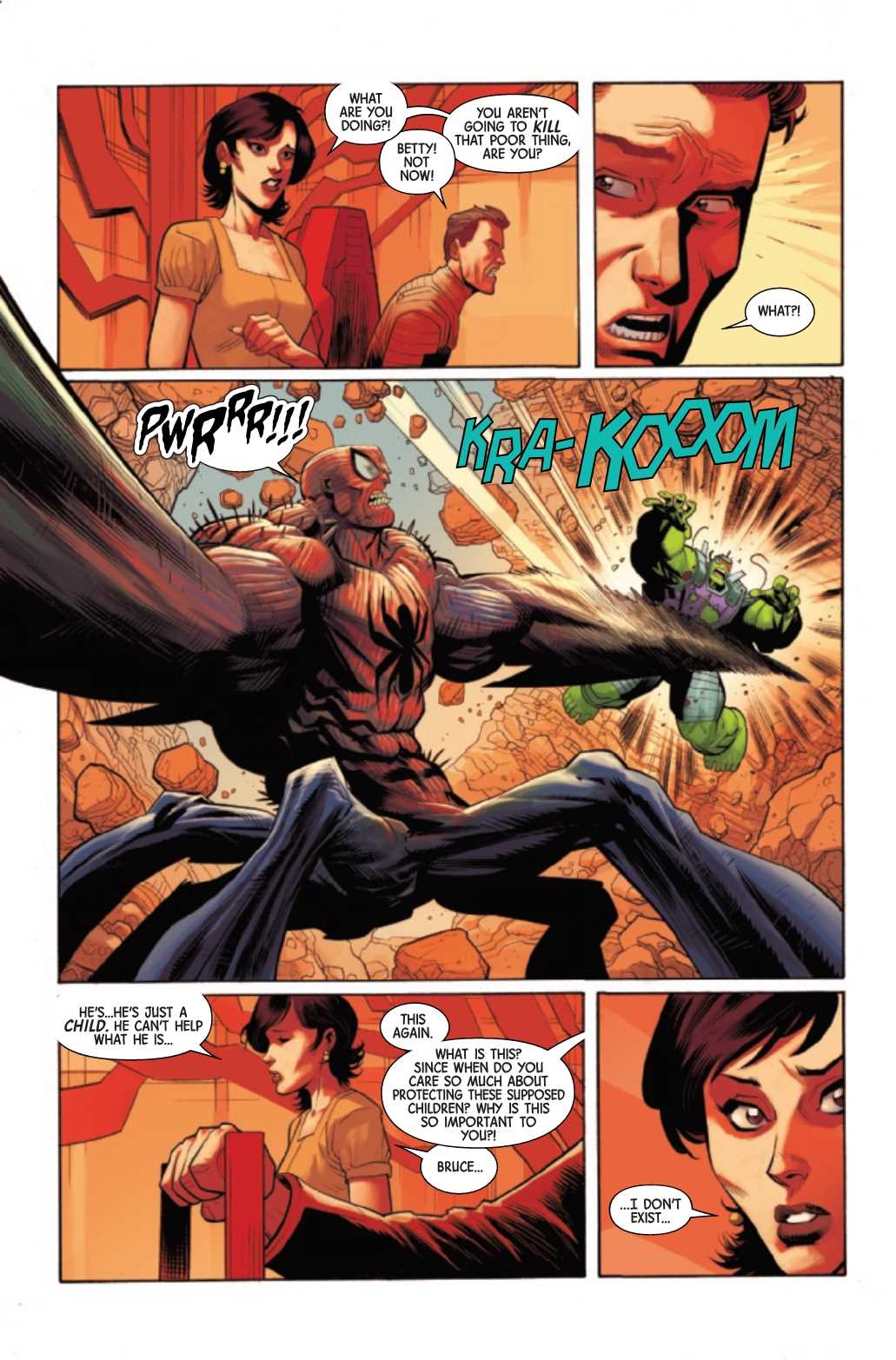
Back in Starship Hulk’s mind-space, “our” Banner pleads for Betty Ross to help him as he tumbles towards the darkness. She turns away, saying that she “isn’t real,” and walks over to the lever, increasing the threat level of the original Hulk’s simulation to Stage Six, pitting him against demons.
What follows is a fast-paced sequence that rapidly cuts between the four scenes already established in the book — the variant Banner yelling that the Abominations are people, not monsters, the strange air-dropped objects opening to release several Abominations to face Starship Hulk, “our” Banner barely holding on to the wall in the mind-space, dangerously close to falling into oblivion, and the original Hulk being overcome by his false foes.
The not-Betty Ross stands over Bruce Banner, calling him “son” and saying that she is “proud of him” before tossing him out into the darkness. She assumes control of Starship Hulk, increasing the simulation’s threat level to Stage Nine — its maximum level. As she does so, Starship Hulk yells out before firing a powerful laser beam that incinerates the Abominations — and that is where the issue ends.
A Villain Revealed
Donny Cates enters the story arc’s conclusion with the revelation of the false Betty Ross as a malevolent entity and her takeover of Starship Hulk. This answers the ongoing question of her nature, a plot thread that has existed since the first issue of Cates’s run while leaving several questions unanswered for the finale — what exactly is she? Why did she call Banner “son?” What did increasing the original Hulk’s simulation threat level to Stage Nine do to Starship Hulk? What will become of the variant Bruce Banner? In this way, Cates sets up all his plot points to be resolved in the final chapter of the story arc.
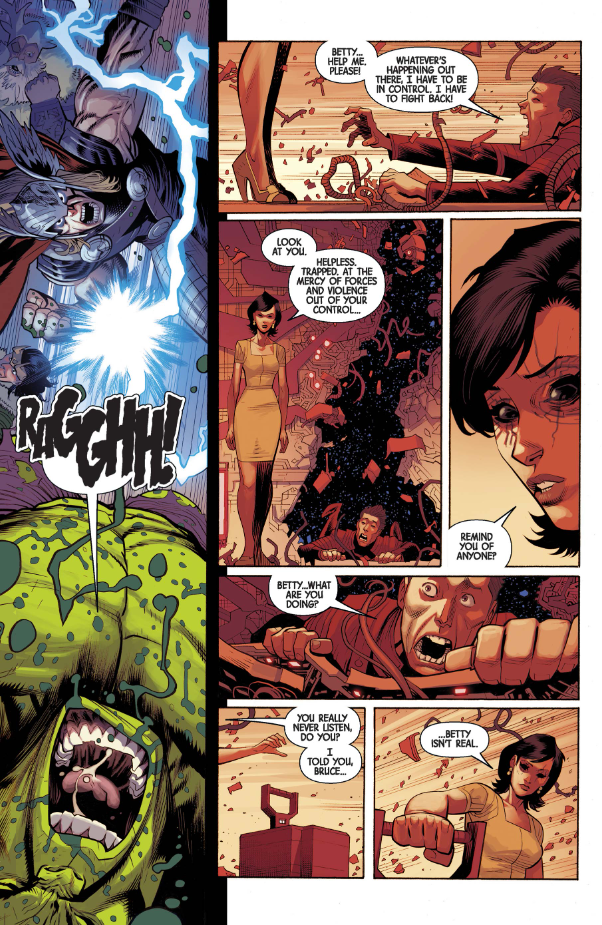
The main innovation of Hulk #5 compared to Cates’ previous issues of Hulk is his use of rapid cuts from one scene to another. While these cuts succeed in creating a sense of increasing tension, they also may serve to confuse the reader or break up the “flow” of the book. The momentum of the book’s first scenes is interrupted by the switch from one scene to another. Since each snippet of the scene lasts a few pages, the readers are given just enough time to get invested in the story before it jumps to another scene.
While it could be argued that this is intentional and a literary strategy on the part of the author, some readers may find themselves taken out of the story by it and struggling to follow the plot. Thematically noteworthy is Cates’s decision to have the variant “Thunderbolt” Ross call himself a “patriot.” While the current run of Hulk has thus far been reflecting the book’s classic Cold War-era themes of the dangers of nuclear power and corruption in government, this line might be interpreted as evoking more recent developments in American politics, such as the violent actions of radical groups calling themselves “patriots.”
While a small moment within the issue, it may signify that Cates intends the variant Ross to embody more modern forms of corruption in America as well as the Cold War-era corruption that he was originally created to represent.
Nonstop Brutality
Ryan Ottley, Cliff Rathburn, and Frank Martin deliver their most shocking issue yet. The art team has done a great job of ramping up the horror factor issue by issue, culminating in the bloody interrogation scene that opens Hulk #5. This scene affects the reader in a different way than the previous, more fantastical, scenes of violence — while the Hulk and his foes are larger-than-life characters engaged in superhero battles, the variant Banner is just a human being beaten by another, crueler human being, inciting a more visceral reaction.
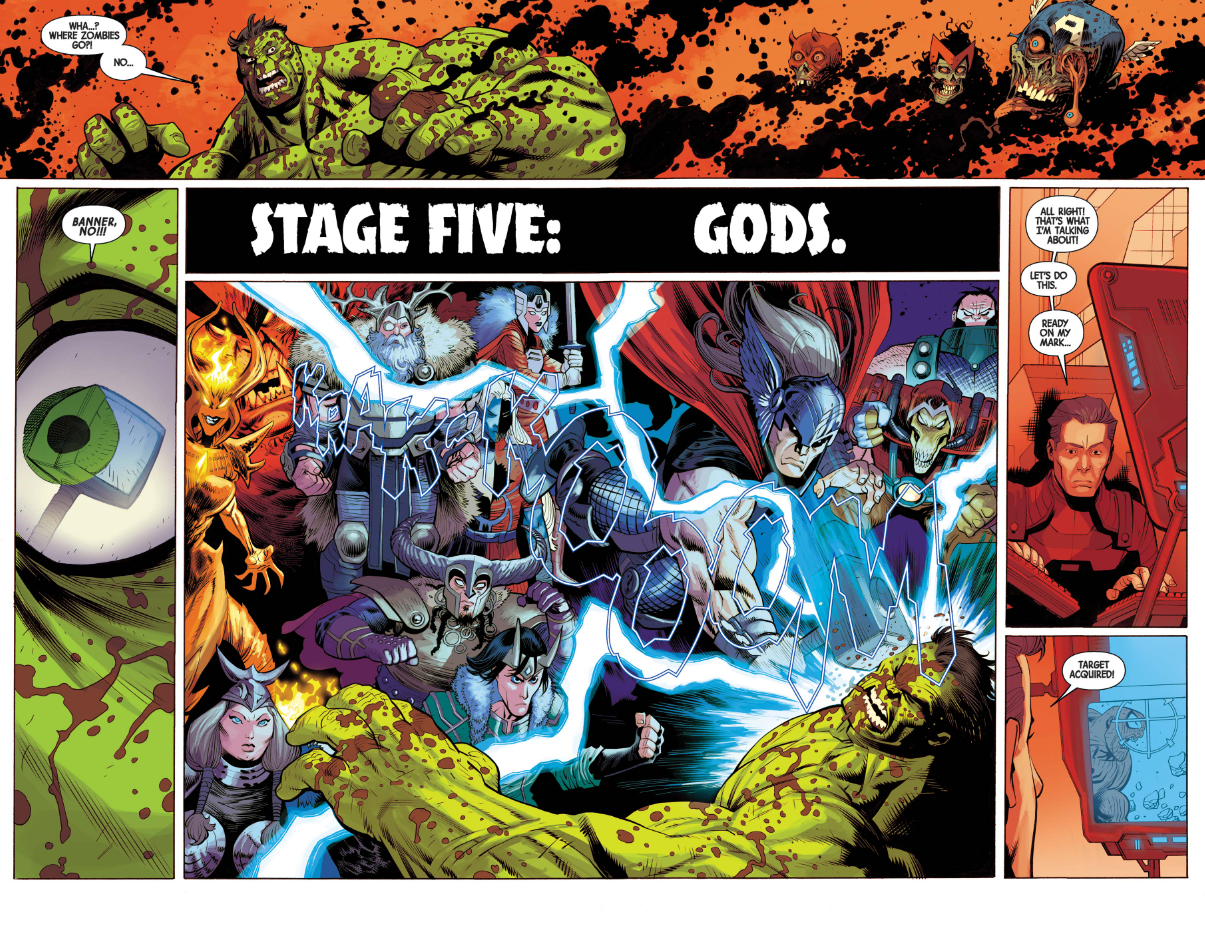
The proliferation of large panels, splash pages, and two-page spreads that characterized the book so far continues in this issue. The fight between Starship Hulk and Spider-Hulk is bombastic despite the comparatively little panel time devoted to it. Particularly impressive, as before, are the art team’s renditions of the original Hulk’s illusory enemies. We get to see them draw essentially the entire main cast of Thor as well as classic Marvel villains Mephisto and Dormammu — characters you normally wouldn’t see in an issue of Hulk.
A Spectacular Penultimate Issue
As the creative team’s first story arc moves towards its endgame, they prepare to answer the book’s main mystery thus far — the identity of the false Betty Ross — while continuing to maintain its focus on action.
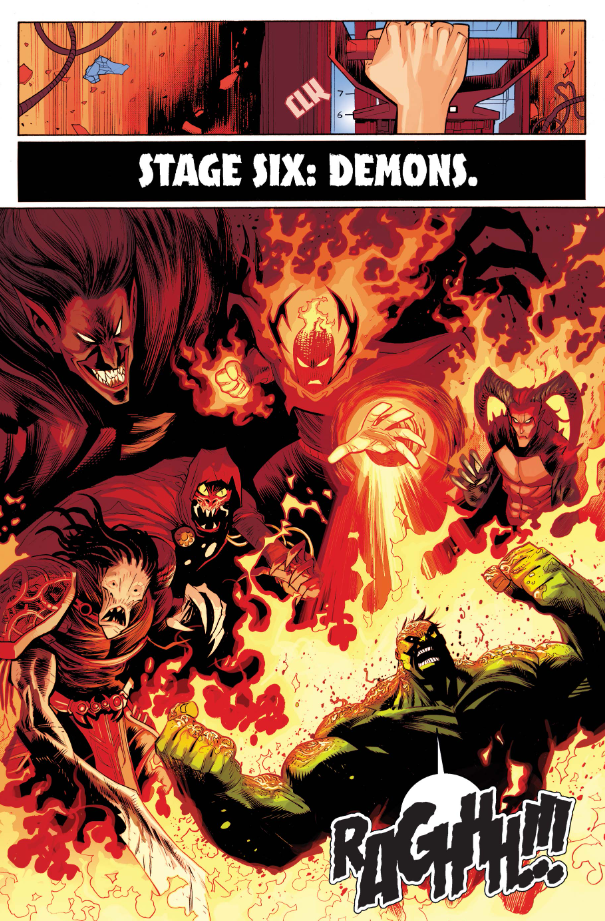
While rapid cuts from scene to scene may confuse readers, Hulk #5 stands as an excellent prelude to the story arc’s finale.
